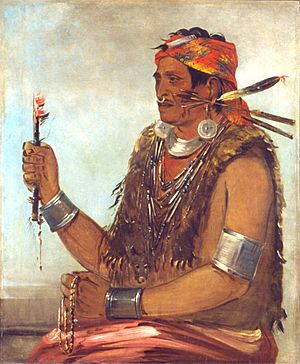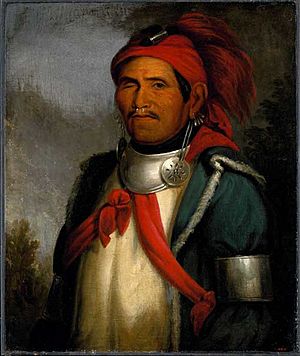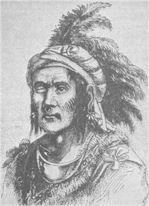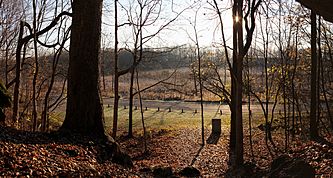Tenskwatawa facts for kids
Quick facts for kids
Tenskwatawa
|
|
|---|---|
 |
|
| Born | c. January 1775 Ohio |
| Died | c. November 1836 Argentine District, Kansas City, Kansas |
| Resting place | Near White Feather Spring, Kansas City, Kansas |
| Nationality | Shawnee |
| Relatives | Puckenshinwa (father)
Methoataske (mother) Tecumseh (brother) Kumskaukau (brother) |
Tenskwatawa (pronounced ten-SKWAH-tah-way) was an important Native American religious and political leader. He belonged to the Shawnee tribe and was also known as the Prophet. He was born around January 1775 and died in November 1836.
Tenskwatawa was the younger brother of Tecumseh, a famous Shawnee leader. When he was young, Tenskwatawa was called Lalawethika, which meant "He Makes a Loud Noise." But around 1805, he changed his name to Tenskwatawa, meaning "Open Door." He went from being a struggling young man to a powerful spiritual leader.
Tenskwatawa spoke out against the Americans. He believed they were from an evil spirit. He started a movement to bring Native American tribes together. He wanted them to reject American ways of life and follow their traditional customs.
In the early 1800s, Tenskwatawa and his followers created a community near Greenville, Ohio. Later, in 1808, he and Tecumseh built a village called Prophetstown in what is now Lafayette, Indiana. At Prophetstown, their movement grew. Thousands of Native Americans joined them. Tenskwatawa provided the spiritual guidance, and Tecumseh led the fight. They wanted to resist American authority and keep their traditional ways.
On November 7, 1811, while Tecumseh was away, Tenskwatawa ordered an attack on American soldiers. This started the Battle of Tippecanoe. The Native Americans had to retreat, and Prophetstown was burned. After this, Tenskwatawa lost his power and moved to Canada during the War of 1812. When Tecumseh died in 1813, the resistance movement weakened. Tenskwatawa returned to the United States in 1824. He helped the U.S. government move the Shawnee to land in Kansas. He died in Kansas in 1836.
Contents
Early Life and Family Background
Tenskwatawa was born Lalawethika in early 1775. He was one of three brothers born at the same time. Their parents were Puckeshinwa and Methoataske. They lived in a Shawnee village along the Mad River in western Ohio. One of his triplet brothers died young. Tenskwatawa and his other triplet, Kumskaukau, grew up in a family with at least eight children.
Tenskwatawa's father, Puckeshinwa, was a Shawnee leader. He was killed fighting against the Virginia militia before Tenskwatawa was born. His mother, Methoataske, may have been Muscogee Creek, Cherokee, or Shawnee. She was very sad after Puckeshinwa's death. She may have left Tenskwatawa and his siblings with their older sister, Tecumpeas.
Tenskwatawa was not as successful as his brothers when he was young. He struggled with hunting and fighting. His older brother, Tecumseh, was a skilled hunter and warrior. Tecumseh was seven years older and very popular. Tenskwatawa felt lonely and insecure. He even accidentally blinded himself in one eye with an arrow. He tried to make up for his struggles by boasting. As he got older, he became more depressed. He found it hard to support his wife and children.
In 1794, Tenskwatawa was at the Battle of Fallen Timbers with Tecumseh. But he did not become a hero in the battle. In his late twenties, he decided to become a medicine man. He learned from a tribal healer. However, he could not save his people when they got very sick. This made him feel even more humiliated and sad.
The Purification Movement
After the Battle of Fallen Timbers in 1795, Native American tribes signed the Treaty of Greenville. They gave up most of modern Ohio to the American government. In return, the Americans promised they could keep the rest of their land. But after 1803, American officials like William Henry Harrison wanted more land. They pressured tribes to give up more territory.
President Thomas Jefferson and Harrison wanted tribes to adopt American customs. They hoped this would make tribes more willing to give up land. They also tried to put tribes in a difficult financial situation. Many tribal leaders, like Black Hoof, tried to get along with the Americans. They encouraged their people to adopt European customs.
Harrison convinced some chiefs to give up large areas of land. The American government paid for this land, but often much less than it was worth. They also bought land from tribes that didn't have the strongest claim to it. Meanwhile, American settlers moved onto Native American lands. All these things made many Native Americans unhappy. They started to lose trust in their chiefs who worked with the Americans. This set the stage for a new movement.
In 1805, Lalawethika had several religious visions. These visions changed his life. He changed his name to Tenskwatawa, meaning "Open Door." He decided to reject his old ways. His first vision was in May 1805. He fell unconscious and was thought to be dead. But he woke up and told of a powerful vision. He saw two worlds: one good for those who lived right, and one bad for those who didn't.
Tenskwatawa became known as "The Prophet." He began to preach and gained many followers. He became a powerful spiritual leader. More visions followed. He said that the European settlers were "children of the evil spirit."
The Prophet's movement urged his followers to reject European ways. He wanted them to return to their traditional customs. He told them not to marry white people. He also told them to avoid American foods, clothes, and goods. Tenskwatawa also encouraged traditional gender roles. Women were farmers, and men were hunters and warriors. He was strict with those who disagreed with him. He accused people who worked with settlers of witchcraft. He believed these "witches" were agents of evil spirits. He wanted to find and stop them.
Founding Greenville and Prophetstown
Tenskwatawa became a good speaker and a strong leader. In 1805, he formed a new community. It was along the White River, near present-day Greenville, Ohio. Harrison, the governor of Indiana Territory, didn't believe Tenskwatawa. He challenged him to perform a miracle, like making "the sun to stand still." Tenskwatawa correctly predicted that an eclipse would happen on June 16, 1806. This made his followers believe in him even more. It also embarrassed Harrison.
The Prophet disliked the leaders of the United States government. He also opposed some tribal leaders who worked with the government. He felt they gave in to American demands. When some chiefs tried to make peace, Tenskwatawa spoke out against them. He called them traitors.
Tenskwatawa continued to preach unity among his people. He urged them to resist the American way of life. Meanwhile, Tecumseh began to gather tribes at Greenville. They wanted to create a large Native American resistance movement. Ohio officials worried about the growing number of the Prophet's followers. As settlers became more hostile, Tenskwatawa found it hard to feed his growing village. He decided to move his followers farther west. He wanted to be away from the settlers.
In 1808, Tenskwatawa and Tecumseh founded a new village. It was along the Tippecanoe River, near present-day Lafayette, Indiana. Settlers called it Prophetstown, after the Shawnee spiritual leader. Prophetstown quickly grew into a large community. It became a powerful Native American "city-state" for the Prophet's movement. It was the largest Native American community in the Great Lakes region. It was a center of Native American culture. It also served as a barrier against settlers moving west.
Prophetstown was located where the Wabash and Tippecanoe Rivers met. This made it an important place for Tecumseh's political and military alliance. It was also the spiritual center of the Prophet's movement. Under their leadership, thousands of Algonquin-speaking Native Americans came to the village. About 14 different tribal groups lived there. Most were from the Shawnee, Delaware, and Potawatomi tribes. The growing community made settlers fear that Tecumseh was building an army.
The increasing alliance led to pressure from Harrison and the U.S. government. They wanted more land treaties. In 1809, the Treaty of Fort Wayne was signed. Tribes in the Wabash River area gave up millions of acres of land. Tenskwatawa and Tecumseh strongly opposed this treaty. They wanted to remain independent. They became angry with those who signed it. They also started talking about an alliance with the British.
War with the United States
Tenskwatawa was the spiritual leader of Prophetstown. From 1808 to 1811, his teachings became more focused on fighting. Some people left Prophetstown because of the rising tension. But Tecumseh and Tenskwatawa continued to recruit young warriors. By 1811, white settlers and Governor Harrison were worried about the large number of Native Americans at Prophetstown. Negotiations between Harrison and Tecumseh failed. Harrison decided to attack first.
In the fall of 1811, Tecumseh traveled south to meet other tribes. He hoped to build a larger alliance. Tenskwatawa was left in charge of Prophetstown. Before Tecumseh left, they agreed to avoid fighting while he was away. However, Tenskwatawa changed his mind. He prepared his warriors to fight if settlers came near Prophetstown. Meanwhile, Harrison and his men marched toward Prophetstown. They built a new fort, Fort Harrison, to prepare for battle. As Harrison's army approached, Tenskwatawa decided to stand and fight.
On November 6, 1811, Harrison's army of about 1,000 men reached the village. Tenskwatawa asked for a meeting with Harrison to delay a fight. Harrison agreed to talk the next day. Harrison and his men camped about a mile from Prophetstown.
Tenskwatawa's force had 600 to 700 men. They had little ammunition. But they attacked before dawn on November 7. This attack started the Battle of Tippecanoe. Tenskwatawa had told his warriors that his spells would protect them. He said they would be immune to bullets and confuse Harrison's army. The warriors tried to surround Harrison's army. After a two-hour fight, Tenskwatawa's forces retreated. They abandoned Prophetstown to avoid capture. On November 8, Harrison's army burned the village.
The battle did not end Native American resistance. But Tenskwatawa, who was not a good military leader, lost his influence. Some Native Americans wanted to kill him for the loss. He survived, but became an outcast. When Tecumseh returned, he took back his role as military leader. But the loss at Prophetstown ended his efforts to create a stronger alliance. Tenskwatawa moved to Canada. He became a subordinate to Tecumseh during the War of 1812.
The Native American military resistance ended in Canada. Tecumseh and his warriors fought to defend the Canadian colonies. Tecumseh was killed at the Battle of the Thames in October 1813. Tenskwatawa watched the battle from behind the British lines. He fled after the American attack. He stayed in Canada for nearly a decade. He did not return to the United States until 1824.
Later Years
After Tecumseh's death in 1813, Tenskwatawa kept a small group of followers. But he no longer had a major leadership role. In 1824, Lewis Cass, the governor of Michigan Territory, asked him to return. Tenskwatawa was asked to help the U.S. government move the Shawnee west of the Mississippi River. Tenskwatawa hoped this would help him regain some influence among his people.
In 1826, Tenskwatawa traveled through Vincennes with 500 Shawnee. They were moving from land in Wapaghkonetta, Ohio. They headed west across the Mississippi and Kansas Rivers. They were going to the Shawnee reservation in present-day Kansas. Tenskwatawa arrived in Kansas on May 14, 1828. He established a village called Prophetstown there. It was in the Argentine district of present-day Kansas City, Kansas.
In his final years, Tenskwatawa's influence among the Shawnee declined. He became isolated from most of the tribe. A few years before he died, he posed for George Catlin. Catlin painted his portrait as a Shawnee "holy man." Tenskwatawa faded into obscurity. He died in 1836, twelve years after moving to Kansas.
Death and Legacy
Tenskwatawa died in November 1836 in his cabin. This site is now in Kansas City, Kansas's Argentine district. The White Feather Spring historical marker, put up in 1978, shows where he is likely buried. His grave was unmarked for many years.
Tenskwatawa's life had both successes and failures. He became a powerful spiritual leader with hundreds of followers. This success lasted about six years. He transformed himself from a struggling young man into an influential religious leader. Tenskwatawa preached unity. He helped improve his people's spirits by encouraging traditional ways. He strongly rejected American authority and their way of life. After the Battle of Tippecanoe, he spent his later years trying to regain his power.
Tenskwatawa and Tecumseh, along with their followers, did not achieve their long-term goals. They lost a difficult struggle that took away their lands. This was mainly due to the strong efforts of the United States. But their defiance was a noble effort.
Many white Americans at the time did not understand the Prophet's religious movement. After his death in 1836, he was often seen as less important than Tecumseh. People who knew Tenskwatawa after 1825, when he had lost his influence, sometimes described him as someone who just looked for opportunities. However, it was Tenskwatawa who provided the spiritual foundation for the Native American resistance movement in the Midwest. This was especially true in the years before the War of 1812.
In the Indiana Territory, the fighting between the U.S. and the Native American alliance led to changes. The territorial capital moved from Vincennes to Corydon, Indiana. Also, U.S. efforts to remove Native Americans from the Indiana Territory increased after the War of 1812. This led to their forced removal to reservations west of the Mississippi River.
See also
 In Spanish: Tenskwatawa para niños
In Spanish: Tenskwatawa para niños
- Native American temperance activists




